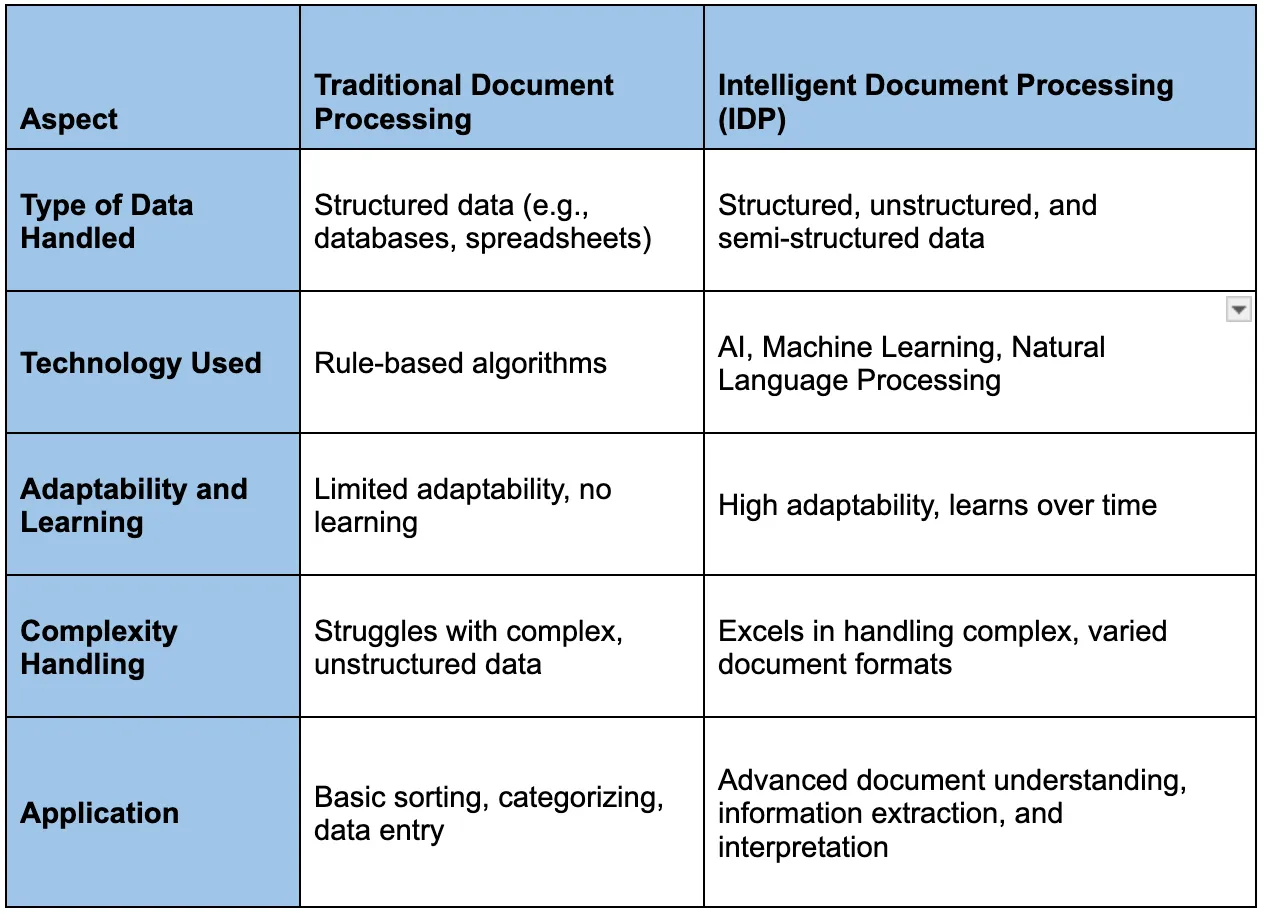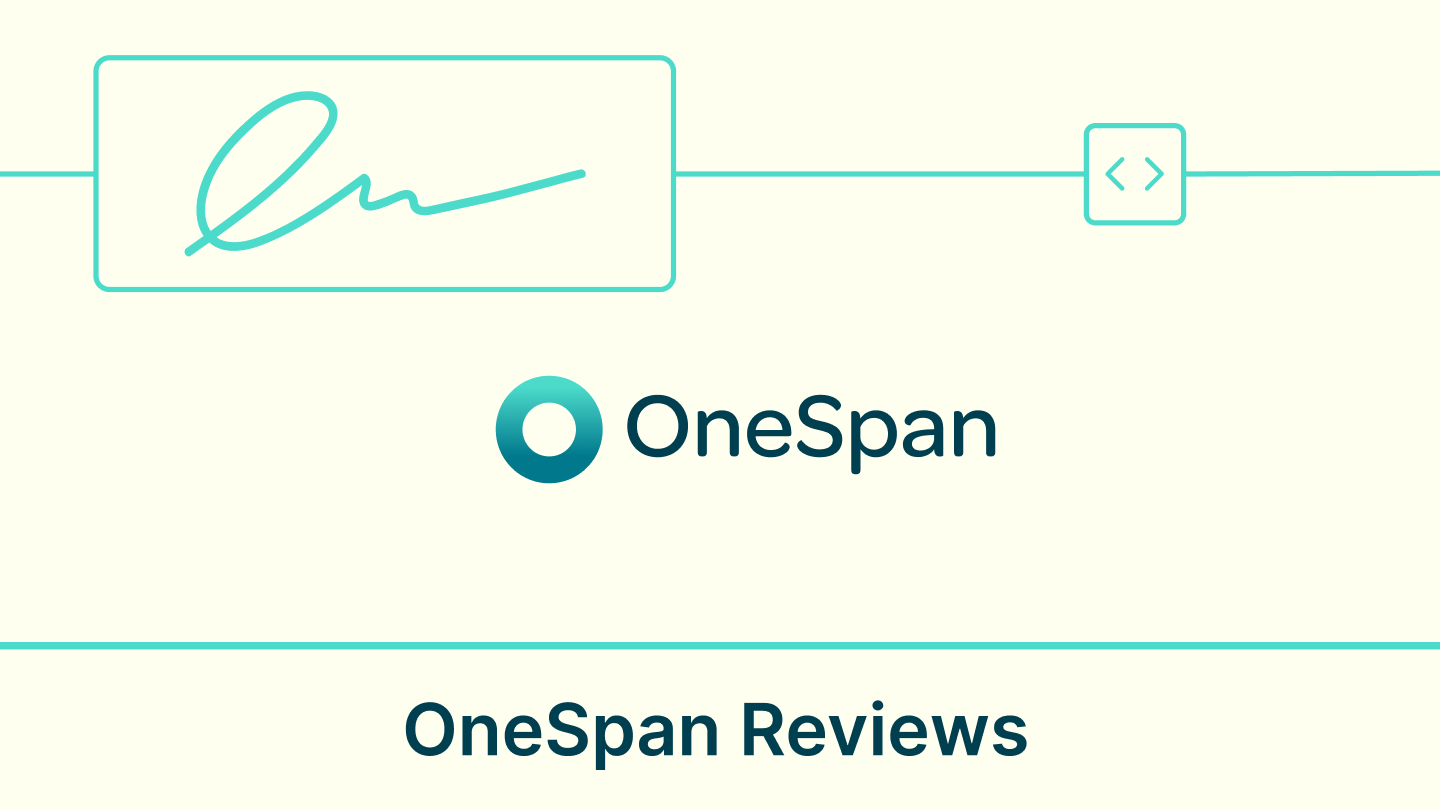Intelligent Document Processing (IDP) is a technology that allows computers to read and understand documents as humans do. It uses AI to automatically organize, read, and interpret information from various documents, whether they're on paper or digital.
This technology makes handling large volumes of documents quicker and more accessible, saving time and effort.
Picture a desk piled high with papers, emails, and digital files. These could include invoices, forms, contracts, and customer emails. Going through this mountain of information is overwhelming. IDP steps in to simplify this task. It scans and analyzes text and data, identifying critical details like dates, names, numbers, and the context of the written content.
The best part? It learns and improves over time. As it processes more documents, it becomes more intelligent.
In a world where digital files are constantly increasing, AI and IDP are becoming essential. Consequently, this has raised several questions: What is intelligent document processing? And Why is intelligent document processing important?
What is intelligent document processing?
Intelligent Document Processing (IDP) stands apart from traditional data processing methods due to its use of AI technologies.
Basic data processing typically involves straightforward, rule-based tasks such as sorting and categorizing. In contrast, IDP uses Artificial Intelligence, Machine Learning, and Natural Language Processing. These advanced technologies enable IDP to understand and interpret complex documents.
Traditional processing is adept at handling structured data but often struggles with unstructured or semi-structured data. IDP, however, is proficient in processing all types of documents. It can extract meaningful information from a wide range of document formats, whether simple or complex.
Its capacity to adapt, learn, and enhance accuracy over time sets IDP further apart. This ability to evolve and improve is a key characteristic distinguishing IDP from standard data processing techniques.

How accurate is intelligent document processing?
Intelligent Document Processing (IDP) typically delivers high accuracy in document handling and data extraction.
However, its accuracy depends on several factors. The quality of the input data, such as the clarity and legibility of documents, plays a crucial role. Additionally, the training and fine-tuning the IDP system receives can significantly impact its accuracy.
With proper setup, ongoing monitoring, and adjustments, IDP can consistently achieve accuracy rates exceeding 90%, making it a valuable tool for reliable document processing.
How does IDP work?
IDP, or Intelligent Document Processing, combines technologies like Optical Character Recognition (OCR), Machine Learning, AI, and workflow integration. This blend streamlines how documents are handled, improves data accuracy, and enhances efficiency in organizations. With tools that allow businesses to sign documents online, organizations can extend the benefits of IDP by digitizing their entire document approval and workflow process. It’s especially useful in reducing manual data entry, reducing errors, and speeding up business processes.
1. Automated data extraction
IDP makes extracting data from documents like invoices and contracts easier. It uses OCR to turn text from paper or scans into digital data, much faster than manual entry.
For instance, IDP can quickly pull out details like invoice numbers and due dates from a document. It uses predefined rules and machine learning to recognize different document layouts better over time.
What is the difference between OCR and intelligent document processing?
OCR (Optical Character Recognition) is a technology that converts scanned text into machine-readable characters, while Intelligent Document Processing (IDP) goes beyond OCR. IDP combines OCR with AI and automation to extract data and understand, categorize, and process documents, making it more versatile and capable of handling complex tasks.
2. Machine learning and AI algorithms
These algorithms are key to IDP’s ability to understand documents better. For example, IDP can identify different types of documents and accurately pick out the needed information. In addition to recognizing document formats, machine learning in IDP continuously analyzes patterns in data to improve understanding and accuracy.
For example, if an invoice layout changes, machine learning algorithms adapt to this change, ensuring accurate data extraction in future instances. This self-improving capability is crucial in environments where document types and formats frequently vary, making IDP systems increasingly reliable and efficient over time.
3. Integration with existing systems
IDP is designed to fit into businesses smoothly, linking with systems like Enterprise Resource Planning (ERP) and Customer Relationship Management (CRM). This means data that IDP extracts can automatically go into the right places in these systems, streamlining workflows.
Key components of IDP
Several key components work in tandem to make Intelligent Document Processing a powerful tool automating document-related tasks, improving data accuracy, and enhancing overall efficiency within organizations.
- Data capture and extraction: IDP systems use OCR and other scanning technologies to digitize paper-based documents. They can extract relevant information from various documents, including structured, semi-structured, and unstructured formats.
- Data classification and sorting: After capturing data, IDP systems classify and sort the information based on predefined categories and criteria. This helps in organizing the data efficiently for further processing.
- Data validation and verification: IDP systems can validate and verify the extracted data against specific rules or external databases to ensure accuracy and completeness.
- Natural Language Processing: NLP is used to understand the context and meaning of the text in the documents. This allows the system to handle complex documents requiring language and semantics interpretation.
- Machine Learning and AI: These technologies enable IDP systems to learn from processed documents and improve over time. They can adapt to new document formats, extract relevant information more accurately, and handle exceptions better.
- Integration with business processes: IDP systems are often integrated with other business applications and workflows. This allows automatic processing of documents and data in various business contexts like finance, legal, healthcare, etc.
Why use intelligent document processing?
Implementing IDP in your organization offers numerous benefits, such as:
- Increased efficiency: IDP automates the processing of large volumes of documents, significantly reducing the time and effort required compared to manual handling. This leads to faster turnaround times for document-related tasks.
- Improved accuracy: Using AI and automation, IDP minimizes human errors in data extraction and processing, leading to higher accuracy in data handling and analysis.
- Cost reduction: Automating document processing with IDP can lead to substantial cost savings by reducing the need for manual labor and minimizing errors that could lead to costly corrections or delays.
- Enhanced data accessibility: IDP makes accessing and retrieving information from documents easier, as data is digitized and organized systematically. This improves overall data accessibility and usability.
- Scalability: IDP systems can easily handle increases in document volume, making them highly scalable solutions for businesses experiencing growth or dealing with fluctuating document processing demands.
Applications of Intelligent Document Processing
IDP finds applications in various domains, such as:
1. Invoice processing and billing automation
IDP is extensively used in finance and accounting departments to automate the processing of invoices. It can efficiently extract key data from invoices, such as invoice numbers, dates, line items, and amounts. By automating this process, organizations can accelerate the accounts payable process, reduce manual data entry errors, and improve cash flow management.
2. Contract management and analysis
When contracts are scanned or digitally uploaded, IDP can extract key details like parties involved, contract dates, obligations, and clauses. NLP capabilities enable IDP to identify and categorize specific contract provisions or clauses. This facilitates quick retrieval of contract information and supports compliance monitoring.
Signeasy AI leverages IDP to efficiently extract essential terms and summarize contract content, enhancing comprehension and providing a clear overview. Users can also sign pdf online free to streamline the contract finalization stage, ensuring a faster and more secure document completion experience. In addition, it can answer specific queries related to the contract, adding an extra level of convenience and efficiency. For more information about Signeasy AI, click here.
3. Customer support and interaction
IDP can analyze customer communications, such as emails, chat transcripts, and support tickets. Organizations can improve response times and enhance customer satisfaction by automatically extracting and categorizing information from these interactions.
Security and compliance considerations
It's crucial to ensure data privacy and protection when dealing with sensitive documents and data, such as financial records or personal information. IDP systems must adhere to stringent data protection regulations, like the General Data Protection Regulation (GDPR) in Europe or the Health Insurance Portability and Accountability Act (HIPAA) in healthcare. This includes implementing encryption for data in transit and at rest, robust access controls, and secure storage practices.
Furthermore, many industries have specific regulations and standards that govern document management and data handling. For instance, financial institutions must comply with regulations like Sarbanes-Oxley (SOX). IDP systems must be configured to assist organizations in meeting these regulatory requirements. This often involves audit trails, compliance reporting, and data retention policies.
Challenges and limitations of IDP implementation
Understanding and addressing challenges and limitations is crucial for organizations planning to implement IDP effectively. While IDP offers substantial benefits, it is essential to recognize its boundaries and proactively manage these limitations to maximize its utility.
1. Handling complex document structures
These challenges primarily revolve around the inconsistent formatting in documents such as legal contracts, invoices, and medical records. IDP systems struggle to accurately locate and extract relevant information when faced with these variations in document formatting.
Additionally, tables, charts, and graphs within documents pose difficulties, as they may cause the loss of context and relationships between data points during extraction. Moreover, some documents contain nested content, such as footnotes or sidebars, making distinguishing between primary and secondary information challenging, resulting in extraction errors.
Organizations can employ advanced document pre-processing techniques to standardize document formats before processing to address this. Continuous monitoring and fine-tuning of the IDP system’s recognition algorithms can also help improve accuracy over time.
2. Dealing with handwritten text and images
Recognition accuracy for handwritten text is a prominent issue, as variations in handwriting styles, legibility, and quality can lead to errors in data extraction. Recognizing handwritten text in multiple languages is complex, as recognition models are often language-specific.
In the case of images, the quality and resolution of the image can vary widely, with low-quality or poorly scanned images leading to inaccuracies in data extraction. Interpreting content within images and handwritten text often lacks the contextual understanding needed for accurate data extraction and interpretation, making these challenges significant hurdles for IDP systems to overcome.
Selecting specialized recognition models and considering language-specific models can enhance the accuracy of handwritten text. When dealing with images, improving image quality during scanning and employing image preprocessing techniques can help minimize inaccuracies. Implementing post-processing checks for handwritten text and images can also ensure data accuracy.
Choosing the right IDP solution
Choosing the suitable Intelligent Document Processing (IDP) solution for your organization is a critical decision that involves assessing your business needs and carefully evaluating potential vendors.
First, identify the types of documents you regularly deal with, their level of complexity, and whether they contain handwritten text or images.
Second, consider the volume of documents to be processed, compliance and security considerations, integration requirements with existing systems, and whether you need a customizable solution.
This assessment will help ensure that the chosen IDP solution aligns with your unique document processing needs and business objectives.
Once you have a clear understanding of your business needs, the next step is to evaluate and select the right vendor and IDP solution:
- Research the market, assess features, and consider costs
- Examine the vendor's reputation for reliability and support
- Perform a proof of concept to evaluate real-world performance
- Prioritize scalability, updates, and future support
- Seek references from other organizations to gain insights into their experiences and satisfaction with the IDP solution











